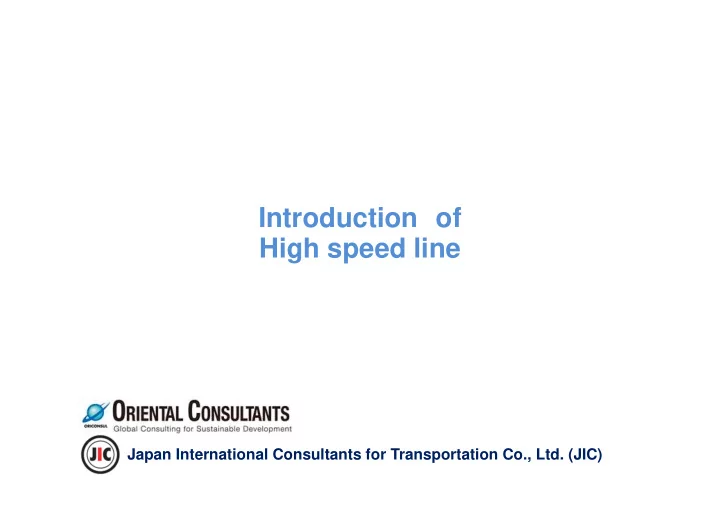

Introduction of High speed line High speed line Japan International Consultants for Transportation Co., Ltd. (JIC)
Index Trend of the HSR Project 1. HSR Project in The World 2. Superiority of Introducing HSR 3. Transport Needs Feature of HSR 1. Rail Tracks 1. Rail Tracks 2. Operation 3. Rolling Stocks 4. Traction Power Supply(TPS) 5. Signaling 6. OCC ( CTC) 7. Environmental Performance 8. Maintenance of Equipment 9. Disaster Prevention 2
Trend of the HSR Project 3
Planned HSR Project in the World UK HSR China HSR (London 〜 Birmingham etc.) (Constructing 21000km until 2020) Thailand HSR ( 4 Lines ) USA HSR ( California Vietnam HSR North-East corridor etc. ) (Hanoi 〜 Ho Chi India HSR Minh ) (6 Lines ) Indonesia HSR Brasil HSR (Jakarta 〜 ( Rio de Janeiro 〜 Sao Paulo 〜 Malaysia HSR Bandung ) Campinas ) (Kuala Lumpur 〜 Singapore ) 4
Planned HSR Project in the World BANGKOK-CHIANG MAI BANGKOK-RAYONG (220km) (750km) 5
Superiority of Introducing HSR Bus 50 Persons Airplane 800 Persons (Data from JORSA) Superiority of HSR ・ Mass Transportation HSR 834 Persons ・ Less Energy Consumption (E4 Series 8 cars/Train) ・ Low Environmental Load 6
Transport Needs Long Distance Transportation percentage in Thailand Bus Train Airplane assenger(million) The use of Train has decreased Passe Transportation percentage in Japan (76) HSR (62) Airplane (38) (24) No Airlines Tokyo-Nagano Tokyo-Aomori Tokyo-Okayama (225km) (700km) (680km) 7
���������������������� ���������������������� Punctuality of Tokaido Shinkansen Accurate Average Train Delay within 1 minute Safe Transportation No Derailment No Passenger/Crew Injured 8
Feature of HSR 9
������������������������������� ��������������� There are many differences between Conventional Railway and HSR. Conventional Railway HSR Below 160 ㎞ /h Over 200 ㎞ /h Speed Rail Tracks With level crossing Overhead crossing Mixed operation Dedicated only HSR Operation Operation and maintenance at the Operation and maintenance at same time the separated time Rolling Stocks Locomotive and Passenger cars EMU Traction Power DC 750V (Metro)or AC 25kV(ARL) AC25kV Supply(TPS) Direct Feeding system AT Feeding system Signaling Visible signal ATC with cab signaling OCC ( CTC) Operated at every signal cabin Operated at one place Environmental Not necessary Necessary (Noise, Inductive Performance interference, Impact sound) Maintenance of Manual inspection and maintenance Mechanical inspection and Equipment maintenance Disaster Prevention Not considered Necessary 10
1. Rail Tracks Suitable Tracks for High Speed Train Double Tracks No Level Crossing No Entry from Outside Overbridge and Underpass Large Radius Curves (over 4000m) Small Gradient 11
1. Rail Tracks Dedicated Track HSR Trains slow down when Conventional Trains run into HSR line Dedicated HSR Track enables Trains run fast. 12 12
2. Operation Separation of Train Operation and Maintenance ( Maintenance Window ) Hour 0 1 2 3 4 5 6 7 8 9 10 11 12 13 14 15 16 17 18 19 20 21 22 23 Maintenance Train Operation Window Maintenance of Equipment We recommend that Time zone of Train Operation and Maintenance should be Separated. 13
3. Rolling Stocks Wind Resistance To reduce the Air Resistance, It is Necessary to Sharpen the Nose Shape of HSR 14
3. Rolling Stocks Locomotive-hauled Train Electric Multiple Unit Train There are two methods for HSR such as locomotive system and EMU. We recommend EMU system for Thailand 15
4. Traction Power Supply(TPS) AT Feeding System Roof-Delta Traction Transformer 16
5. Signaling ATC with Cab Signaling system Brake control Distance of Preceding Train Stopping point Digital ATC Signal LAN Train Control by Distance of Train Keeping Visibility Distance 17 Braking Distance is about 3 km at over 250 km / h
6. Operation Control Center(OCC) The Operation Control Center for Whole Line at One Place. Train Dispatch and Facility Dispatch. 18
7. Environmental Performance Noise-reduction Low-noise pantograph Nose Shape (Aero Double Wing) Bogie Skirt Cover-all hood Cover-all hood Pantograph Cover 19
7. Environmental Performance Improving Inductive Interference Pantograph Reduction Location of AT post (interval of 10km) 20
7. Environmental Performance Impact noise reduction Tunnel Entrance Hood Processing Nose Shape 21
8. Maintenance of Equipment Inspection Train Inspection equipment on Train Equipment Condition is measured regularly by Trains 22
8. Maintenance of Equipment Maintenance Wagon for Tamping Machine Overhead Catenary System Introducing Maintenance Car is recommended 23
9. Disaster Prevention Wayside safety devices 24
• ��������� ��� ���� � ��!� �" ! 25
Recommend
More recommend